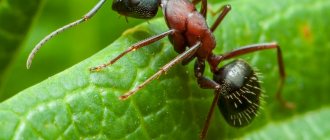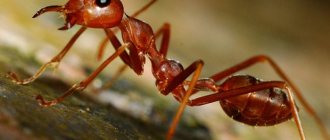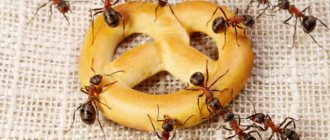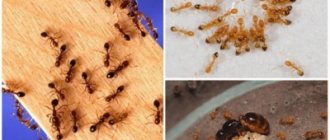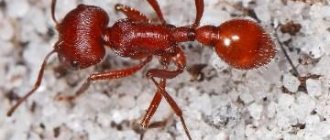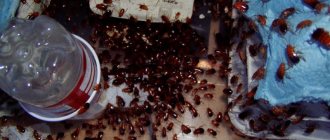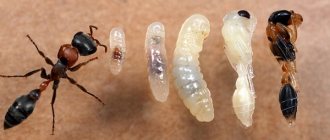A living organism needs rest and sleep. However, looking at the vigorous activity of ants, we can draw conclusions that life in the anthill is in full swing during daylight hours and is unlikely to stop at night.
Ants never sleep in the full sense of the word , but to restore strength and replenish energy resources, these tiny insects can freeze for a couple of minutes several times throughout the day.
This dream can be repeated up to hundreds of times a day. The ability of ants to restore energy reserves with the help of short-term sleep is called a kind of guarantor of protection for the anthill, since most of the colony is always awake.
Do ants sleep
In order to find out whether ants sleep at all, researchers of the insect world placed tiny cameras inside the anthill passages, which monitored the lives of workers of the insect world around the clock.
After some time, recordings obtained through video cameras placed in the colony allowed us to conclude that the ants sleep for short periods of time.
During the day, ants sleep up to two hundred to two hundred and fifty times a day . In this case, the duration of sleep does not exceed one to two minutes. During the specified time, the insect freezes, after which it continues the previously interrupted activity.
The duration of sleep is no more than five hours for workers, soldiers and other inhabitants of the home. However, the queen or queen may nap for eight hours or more.
Why don't ants freeze?
It's no secret that these insects live even in the northern tundra. The range of ants in these latitudes is limited only by the depth of soil thawing. For the successful development of the larvae, it is necessary that the soil has time to warm up to a depth of 10-30 cm. It is at this depth that the passages and chambers of the polar and Kamchatka ants are located.
Many people immediately have a logical question: how do these insects not freeze in winter? After all, only the very top layer of soil thaws, under which permafrost remains, and in winter the ants must inevitably die. But they appear every spring even in the Far North.
The blood of ants (scientifically called hemolymph) contains sugary substances. Carbohydrates accumulate in the tiny body during the warm period, and during cold weather they prevent the liquid from freezing. The insect becomes able to withstand even cooling down to -50 °C.
Naturally, in this case, polar ants enter a state of diapause. They do not move and do not need food. The colony may seem extinct, because in a frozen anthill it is easy to see the frozen bodies of ants, their queen, and even larvae. But as the temperature rises to positive values, they come to their senses and begin to do their usual activities. The larvae in such anthills easily endure 2-3 winters, and only after that do adult workers emerge from them.
Species living in temperate latitudes are protected from frost by both the dome and the deep chambers where the ants overwinter. They do not rise to the upper “floors” of the anthill, protected by their instinct and a decrease in activity during cold weather. An inhabitant who accidentally gets there, feeling discomfort at a certain level of the home, will simply go down to the warm zone. And only when the snow above melts and the sun warms the upper layers of the soil will the ants be able to open the exits from their underground palace.
Coming to the surface, they immediately begin searching for protein food for their queen. Increased feeding encourages her to begin a new egg-laying cycle. New larvae appear in the anthill, and the life of the colony continues.
How do they sleep
Since ants sleep for a minimal period of time, but many times a day, sleep can find a representative of the colony anywhere. While resting, ants tilt their heads and lower their antennae. After a few seconds, the individual wakes up, comes to its senses, and then continues its hike.
Queens or queens sleep in a similar manner. However, the video obtained after conducting round-the-clock monitoring of the life of the colony recorded a peculiarity: if the queen sleeps with her head slightly raised, this indicates shallow sleep. If she sleeps with her antennae and head down, then we are talking about deep sleep, which lasts longer than usual.
How long do they sleep?
How much an ant sleeps depends on the caste of a particular individual. For example, the duration of sleep of the uterus is comparable to the amount of rest needed by the average person, and is about eight hours a day. The remaining representatives of the colony, that is, workers, soldiers, nannies and others, sleep somewhat less - the total sleep duration of such individuals is eight hours.
During the winter period , ants living in areas with moderate or severe climatic conditions can fall into a state of suspended animation, which can also be characterized as prolonged sleep.
As a rule, this is typical only for certain species; some of them spend the winter in a state of half-sleep, when their activity decreases, but does not stop.
The fact that such freezing of individual individuals is precisely a dream is also evidenced by the following: if a sleeping ant is touched by relatives running past, there is no response from this individual. The following can also happen: when a threat arises to the anthill, relatives wake up the sleeping individuals, informing them of the need to protect the colony.
How do ants prepare for winter?
It turns out that not all ants sleep: even in the cold season, some families live a normal life.
Of course, they are deprived of the opportunity to go outside and are less active than in summer, but they do not hibernate, continuing to build tunnels, feed the queen (queen), and sometimes grow mushrooms and care for “domestic animals.” In very cold regions, where the soil freezes to a great depth, ants still spend most of the winter in a sleepy state. But how do ants that don’t have to sleep prepare for winter? To provide the colony with food for the entire cold season and to successfully overwinter, the little workers work throughout the warm season. They catch a huge number of caterpillars, bedbugs, beetles and other insects that are pests of garden crops. Part of the catch is used to feed the larvae, but the rest is stored in special chambers. The supplies may include seeds, killed insects, and plant fruits.
Some worker ants constantly expand the dome of their home. Red forest ants are especially distinguished by this: their “heaps” can reach more than 1 m in diameter and a height of about 50 cm. Inside the dome there are both living chambers and storage areas. The loose material serves as excellent protection from the cold for underground rooms where insects go for the winter.
In an effort to protect the wintering larvae, they are transferred to the most protected chambers, where the temperature does not fall below critical. Young animals need protein nutrition: this is why ants drag a variety of insects into their home. The uterus is also intensively supplied with protein feeds: from this, it begins to lay a special type of eggs - trophic (nutritional). Larvae cannot hatch from them, but the eggs themselves serve as food for the queen in winter.
When ants sleep
Ants sleep at any time of the day. Despite the fact that at night the anthill’s connection with the outside world is interrupted until morning, which implies the closing of the passages, life continues to boil directly inside the colony. As for sleep during the cold season, individuals that hibernate are in a state of suspended animation until the weather warms up and the snow melts.
Scientists have identified a peculiarity : the body of ants in a state of hibernation continues to function, but in a slow motion. In this way, insects conserve the body’s energy resources, which allows them to consume less food than usual. In part, it is this specificity of life activity that allows the colony to survive a period of prolonged cold weather.
Do they sleep at night?
So, the life of an ant colony is in full swing around the clock; at night, individual representatives do not sleep, protecting the anthill and caring for the larvae. It is especially important to protect the colony from various external factors, for example, enemies, natural disasters - floods, fires.
When a threat appears, adults exhibit an immediate reaction, which may differ according to caste. For example, nurse ants strive to immediately move the queen and larvae to a safe place, soldiers prevent an attack on the colony of other insects.
The absence of night rest allows the colony to prevent attacks from other insects and mammals that hunt during this time of day.
The queen or queen also sleeps throughout the day; scientists have not identified the dependence of the duration of her sleep on the period of the day. However, during the cold season, the queens of most ant species sleep - they fall into a state of suspended animation, do not lay eggs, and their food and energy needs are significantly reduced.
Interesting facts about ants
Ants are an amazing insect species with interesting behavioral characteristics.
The following facts indicate that the life of these workers differs from other representatives of the insect world::
- Regardless of caste, individual representatives of the species are distinguished by a high level of intelligence. Ants placed in complex labyrinths are faster than other insects in choosing the right direction and finding exits.
- Ants are considered to be among the most ancient representatives of the insect world, living on planet Earth unchanged. Scientists have found fossils of these tiny creatures that are one hundred million years old.
- These insects are omnivores. They can attack other arthropods and feed on organic matter, such as rotten plant roots.
- One adult can lift a load that exceeds its own body weight.
- Ants continue to feed individuals who have lost the ability to obtain food, for example, due to injury or illness. This lasts exactly as long as the mutilated individual retains the ability to tap its antennae on the heads of its fellows, thereby giving a kind of conditioned signals.
- Kindred may execute individuals whose duties include gathering food. This happens if the ant returns back without food supplies several times in a row. If this happens repeatedly, such an individual becomes food itself.
- In tropical countries, there are species of predatory ants that destroy everything in their path, be it plants or animals. Even lions and other mammals avoid encounters with these tiny predators.
- The ants contain “livestock,” which are called aphids. Working representatives of the colony provide constant care for the “pets”, receiving a sweet substance rich in nutrients.
- Contrary to popular belief, some members of the colony are unique drones. When eighty percent of the population of an anthill is busy arranging housing, protecting it, and obtaining food, twenty percent of the colony is busy. Changes do not occur if the number of hard workers decreases for certain reasons. What causes this specificity remains a mystery.
Based on the above, we can draw conclusions: these tiny workers spend most of their lives awake and sleep very little. They require short-term, shallow sleep, which restores performance and replenishes the energy reserves of the insect’s body.
What do ants do in winter?
Those families that are not in a state of diapause have no less work than in the summer. The main occupation of colonies that hibernate only as adults is repairing tunnels and chambers. Some of the workers still care about the queen of the colony: they have to feed her. The female's diet becomes only slightly poorer in protein than in summer. This prompts her to stop laying new eggs, the larvae of which could lead to starvation of the entire colony, since it is quite difficult to preserve a large amount of protein food.
Among ants of temperate climates, other organisms can spend the winter in a relatively warm home. Many species are very fond of the sweet secretions of aphids. To do this, they transfer small insects to the chamber of the anthill, where they are kept as pets for some time. Some families of ants grow microscopic fungi, which are perfectly suited to the microclimate of underground caves.
Insects living in an anthill can be ordinary parasites. They master the behavior of their owners and behave in such a way that they feed them. To do this, there is a series of specific touches with the antennae, which the “freeloaders” reproduce. There are about 2,000 species of beetles, bedbugs and butterflies, which thus spend the winter in relatively comfortable conditions.
But the Lomechusa beetle has adapted best to life with ants. His female even allows herself to lay eggs in the chambers where the offspring of the owners themselves are located. The secret of this behavior lies in a certain substance that acts on ants like a drug. The substance is secreted by both adult Lomechusa and its larvae, which grow together with ants.


